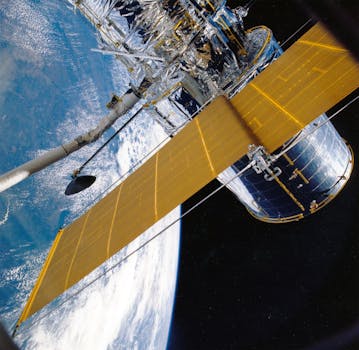GEO Satellites: Understanding the Technology and Applications of Geostationary Orbit Satellites

GEO Satellites: Understanding the Technology and Applications of Geostationary Orbit Satellites
GEO satellites, or geostationary orbit satellites, are a type of satellite that orbits the Earth at an altitude of approximately 36,000 kilometers, which is the exact distance required for a satellite to remain stationary relative to a fixed point on the Earth’s surface. This unique characteristic allows GEO satellites to provide a wide range of services and applications, including telecommunications, Earth observation, and weather forecasting.
GEO satellites have been in use for several decades, with the first geostationary satellite, Syncom 2, launched in 1963. Since then, the technology has evolved significantly, with modern GEO satellites offering high-speed data transmission, advanced imaging capabilities, and improved navigation systems. The focus keyword GEO satellites is used to describe these satellites, which play a vital role in modern telecommunications and Earth observation systems.
How GEO Satellites Work
GEO satellites work by orbiting the Earth at a speed that matches the planet’s rotational period, which is approximately 24 hours. This allows the satellite to remain stationary relative to a fixed point on the Earth’s surface, providing a constant and reliable signal. The satellite’s orbit is also designed to be geosynchronous, meaning that it orbits the Earth at the same speed as the planet’s rotation, which ensures that the satellite remains above the same point on the Earth’s surface at all times.
The satellite’s communications system consists of a transmitter and receiver, which are used to send and receive data to and from the Earth. The transmitter sends a signal to the Earth, which is then received by a ground station or a user’s device. The receiver on the satellite receives signals from the Earth and transmits them back to the ground station or user’s device. This process allows for real-time communication and data transmission between the satellite and the Earth.
Applications of GEO Satellites
GEO satellites have a wide range of applications, including telecommunications, Earth observation, and weather forecasting. In the field of telecommunications, GEO satellites are used to provide internet connectivity, telephone services, and television broadcasting. They are also used for navigation, providing location information and timing signals for GPS and other navigation systems.
In the field of Earth observation, GEO satellites are used to monitor the Earth’s climate, weather patterns, and natural resources. They provide high-resolution images of the Earth’s surface, which can be used to track changes in the environment, monitor natural disasters, and predict weather patterns. GEO satellites are also used for weather forecasting, providing data on atmospheric conditions, ocean currents, and other weather-related phenomena.
Future Developments and Challenges
Despite the many advantages of GEO satellites, there are also challenges and limitations to their use. One of the main challenges is the risk of satellite collisions, which can cause significant damage to the satellite and disrupt communications services. There is also a growing concern about space debris, which can pose a risk to satellites and other space-based systems.
To address these challenges, researchers and engineers are developing new technologies and strategies for managing satellite orbits and reducing the risk of collisions. There are also efforts to develop more sustainable and environmentally friendly satellite systems, which can minimize the impact of satellites on the environment.

